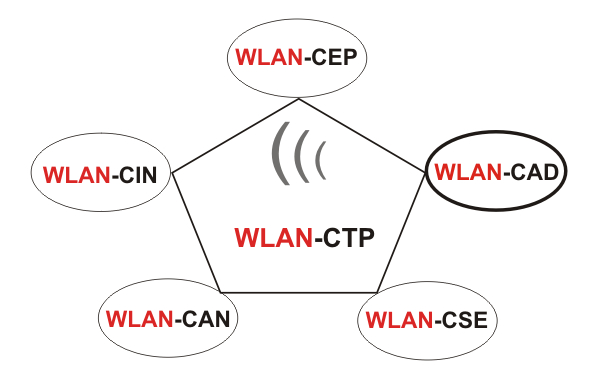Wireless LAN Certified Administration
(WLAN-CAD) / content
The Wireless LAN administration training offers network professional a complete basis in view of the 802.11 (a/b/g), 802.11e and 802.11n standard, to enter and penetrate the Wireless network industry. Starting with the RF theory, going into installation and configuration up to troubleshooting and a site survey the course conveys a training from which not only administrators profit, but all working with the Wireless LAN technology.
Target group
The course is desigened for administators as well as network professional, who want to get a solid understanding of Wireless networks and complete their knowlege of all wired networks.
Duration
The Wireless LAN administration training lasts 5 day of lecture as well as practical training.
Certification
The course is the ideal preparation for the Wireless LAN Certified Administraion and Wireless LAN Certified Expert exams (WLAN-CAD / WLAN-CEP).
Prerequisits
Solid networking knowledge
Content
Organisations and Standards
Wireless LAN organisations
FCC rules
Frequency areas and channels
IEEE 802.11 standards
Bluetooth
Infrared
Radio Frequency (RF) basis
RF behaviour
Principals of antennas
Transmitting power regulations
RF calculations
Hardware installation, configuration
Access points
Wireless LAN Switches
Wireless LAN bridges
Wireless LAN workgroup bridges
Client devices
Residential gateways
Enterprise gateways
Antennas and Tools
Omni-directional
Semi-directional
Directional
Coverage regulations
Installations and security rules
Accomplishment of outdoor/indoor installations
Power over Ethernet
Required cables and tools
Spread Spectrum Technologien
Usage of Spread Spectrum
Spreading code and modulation
Frequency Hopping
Direct Sequencing
Comparison between DSSS and FHSS
Co-location and throughput-analysis
Physical und MAC Layers
Differences between Wireless and ethernet frames
Collision handling and usage of RTS/CTS
Throughput and automatical speed-selection
Analysis of DCF/PCF
Interframe spacing
Impact of packet fragmentation
802.11 Netzwerk Architecture
Authentication and Association
Basic Service Set
Extended Service Set
Independent Basic Service Set
Roaming in a Wireless LAN
Beacons and Probe Frames
Power Management Features
Troubleshooting Wireless LANs
Multipath
Hidden node
Near/Far
Detection and elimination of interference problemns
System throughput maximization
Co-location throughput maximization
Reusage of channels when roaming
Antenna diversity
Wireless LAN Security
Analysis of the 802.11i security
Available security solutions
Kinds of networking attacks
Protect the network against penetration
Security policies
Security recommendation
Site survey
Requirement analysis
Feasibility study
Interviewing the network managers and users
Calculation of the required bandwidth
Configuration of the RF coverage
Documantation of installation problems
Recognize interferences
Description of the methods and procedures
The introduced topics are completed by numerous practical trainings.
www.wlan-ctp.de, www.wlan-ctp.eu, www.wlan-ctp.com, www.airdefense.de, www.cnti.de
